the Creative Commons Attribution 4.0 License.
the Creative Commons Attribution 4.0 License.
Correction of sea surface biases in the NEMO ocean general circulation model using neural networks
Sergey Frolov
Laura Slivinski
Chunxue Yang
The atmospheric forcing and the heat exchanges between the ocean and the atmosphere represent one of the major sources of uncertainty for numerical ocean reconstructions and predictions, together with inaccuracies in vertical mixing and solar radiation penetration. Air–sea heat fluxes may suffer from inaccuracies in meteorological fields, sea surface variables, and bulk formulations, which have a strongly nonlinear dependence on the ocean state. Here, state-dependent errors in heat fluxes are learned by artificial neural networks (ANNs) from a dataset of heat flux correction terms, derived in turn from previous sea surface temperature nudging experiments. The pre-trained model predictors include stationary fields, atmospheric forcing data, ocean state, and stratification indices. Variable importance scores emphasize the dependence of air–sea heat flux errors on wind forcing. The pre-trained heat flux correction model is then used to adaptively correct fluxes online, in a series of global ocean experiments performed with the NEMO version 4 (Nucleus for European Modelling of the Ocean) ocean general circulation model, augmented with ANN inference capabilities in Fortran90. Results indicate the positive impact of the correction procedure, beyond the training period, e.g. in independent observation–poor and –rich periods, leading to the same dynamic and subsurface signature as in nudging experiments. Prediction experiments also indicate the method's potential for use in operational forecast applications. The method may also be adopted in coupled long-term reanalyses, long-range predictions, and projections.
- Article
(4778 KB) - Full-text XML
- BibTeX
- EndNote
The ocean and the atmosphere interact by exchanging momentum, heat, and freshwater. These interactions drive ocean circulation and ventilation (e.g. Marzocchi et al., 2021) and its energy and water budgets, which are crucial to understanding the ocean's role in the Earth's climate and its variability over a wide range of spatial and temporal scales (e.g. Roberts et al., 2016; Small et al., 2019). Unfortunately, direct measurements of these fluxes are only available in limited buoy locations, making global and precise estimating of air–sea fluxes a challenging problem (Cronin et al., 2019). Typically, air–sea fluxes are estimated using bulk flux parameterizations, which rely on near-surface meteorological variables, obtained from numerical weather prediction systems or atmospheric reanalyses (e.g. Yu, 2019). Bulk formulations are strongly nonlinear, and there are significant uncertainties in these parameterization-based flux estimates (e.g. Huber and Zanna, 2017); when averaged over ocean basins, heat fluxes may result in considerable imbalances (see e.g. Kato et al., 2013; Storto et al., 2016a; Valdivieso et al., 2017). Inaccuracies in ocean model vertical mixing and solar radiation penetration schemes interplay with the inaccuracies in the air–sea fluxes and may amplify the sea surface errors (e.g. Deppenmeier et al., 2020; Jia et al., 2021; Richards et al., 2009).
For both retrospective ocean simulations (e.g. OMIP, Ocean Model Intercomparison Project; Griffies et al., 2016), long-term reanalyses (Storto et al., 2021), and coupled model simulations (e.g. CMIP, Coupled Model Intercomparison Project, Small et al., 2019), systematic errors at the sea surface affect ocean heat redistribution (convection, stratification, and large-scale circulation), potentially compromising climate change signals (Storto et al., 2016a; Carton et al., 2018). Errors at the air–sea interface thus remain among the most critical sources of uncertainty for many numerical ocean applications, including climate monitoring (e.g. Hakuba et al., 2024) and operational forecasting (e.g. Lewis et al., 2019; Lin et al., 2023; Ohishi et al., 2024).
Attempts to empirically correct errors in the fluxes have generally developed along two directions: (i) bias-correction methodologies applied directly to ocean variables, i.e. correcting the effects of air–sea heat flux systematic errors, see e.g. Balmaseda et al. (2007); (ii) calibrating atmospheric reanalyses through comparison with observed climatology (Large and Yeager, 2009; Brodeau et al., 2010; Tsujino et al., 2018). Both strategies have their merits and weaknesses. Bias-correcting ocean variables requires an adequate and dense ocean observing network – namely, the Argo float network limited to the period from ∼ 2005 onwards – and cannot be used for attributing ocean model errors to specific processes. On the other hand, calibrating atmospheric reanalyses can mitigate errors in the atmospheric forcing but not in the bulk formula approximations, and, therefore, is only partially able to improve air–sea heat fluxes. Stochastic approaches can also, to some limited extent, improve the estimation of air–sea heat fluxes through rectification of the mean ocean state (Agarwal et al., 2023; Storto and Yang, 2023).
In this work, we use a state-of-the-art ocean general circulation model to demonstrate a neural-network-based predictor–correction empirical relationship to correct the non-solar component of air–sea heat fluxes and reduce sea surface temperature (SST) biases. As neural networks have been proven to be universal approximators of any function (Hornik et al., 1989), they represent an obvious and flexible choice to model nonlinear relationships between the atmospheric and oceanic states and heat flux errors. Indeed, previous work (Bonavita and Laloyaux, 2020; Chen et al., 2022; Chapman and Berner, 2024) has shown their ability to infer systematic errors in atmospheric models. The use of data assimilation increments was also demonstrated to be a robust strategy to learn such errors, with both theoretical (e.g. Mitchell and Carrassi, 2015) and practical (Farchi et al., 2021; Chapman and Berner, 2024) arguments. The relationship is learned offline from present-day ocean model simulations that exploit the availability of spaceborne SST to estimate a corrective heat flux term. The correction is then tested online in ocean model simulations, for periods beyond the learned (training) one.
The article's structure is as follows: after this Introduction, Sect. 2 describes the modelling system, the neural network setup, the relevant datasets, and the experimental setup. Section 3 summarizes the results of the reconstruction of the corrective heat flux terms and online correction experiments, while Sect. 4 discusses and concludes.
2.1 The NEMO model and the nudging scheme
In this work, we use the NEMO ocean model (version 4.0.7, Madec et al., 2017), including the sea ice dynamic and thermodynamic model SI3. NEMO is implemented on the ORCA1 grid (at 1° of horizontal resolution with refinement in the tropics), with 75 vertical depth levels and partial steps (Barnier et al., 2006). We use the same model configuration as in the CIGAR reanalysis (Storto and Yang, 2024), briefly recalled here. The surface boundary conditions are calculated through the CORE bulk formulas (Large and Yeager, 2009) implemented in the AEROBULK package (Brodeau et al., 2016), using meteorological variables extracted from the ECMWF ERA5 atmospheric reanalysis (Hersbach et al., 2020). The river discharge from land is provided by the JMA JRA-55-do reanalysis (Tsujino et al., 2018). The model setup includes (i) a 3-band RGB scheme for the net shortwave radiation, with extinction coefficients that depend on a monthly climatology of chlorophyll; (ii) the turbulent kinetic energy (TKE) scheme for the vertical mixing (Gaspar et al., 1990); (iii) a Laplacian operator and a bi-Laplacian operator for tracers and momentum, respectively.
Table 1List of predictors, grouped by categories, with their aggregated variable importance score (VIS), given as percent impact, both as the impact on the pre-trained model (total VIS), and averaged over the global domain from the pointwise application (grid-point-averaged local VIS). MLD: mixed layer depth; OHC: ocean heat content; SSS: sea surface salinity; OSC: ocean salt content; SSH: sea surface height; the suffix _da refers to diurnal amplitude.

In the NEMO model, the air–sea heat flux can be optionally corrected with a nudging scheme (see e.g. Storto et al., 2016b). In practice, the net heat flux is decomposed into a penetrative (solar) component and a non-penetrative (non-solar) component. The non-solar component, which includes latent, sensible, and net longwave heat flux, can be corrected as:
where the misfit between the observed (SSTo) and modelled (SST) sea surface temperature, multiplied by the nudging coefficient (or strength) κ, represents the corrective flux Qrp added to the uncorrected non-solar flux. SST nudging is still a popular assimilation methodology for many climate-scale applications, where the use of gap-filled SST data ensures temporal consistency in the simulated ocean state compared to the direct assimilation of SST measurements (see e.g. Yang et al., 2017). A 2000–2020 experiment (referred to as REF) with nudging to the SST data from the UKMO HadISST dataset (Rayner et al., 2003) was conducted, with a nudging coefficient equal to 100 , which roughly corresponds to a 20 d relaxation time scale for a 50 m deep mixed layer. Note that nudging coefficients may be related to error characteristics and set up in a statistically optimal way (e.g. Zou et al., 1992; Vidard et al., 2003), although here, for the sake of simplicity, the nudging coefficient κ is spatially and temporally constant. Additionally, preliminary experiments tested the use of alternative SST datasets, for instance, the NOAA DOISST v2.1 (Huang et al., 2021), but those using HadISST provided the best results and are the only ones considered in the remainder of the article.
Correcting air–sea heat fluxes effectively accounts for multiple sources of bias in the modelled SST, including potential errors in vertical mixing and other oceanic processes. Since the bias is assessed against observations without possible attribution to a specific error source, the method serves as a general SST bias correction strategy. Additionally, the correction is applied to the air–sea heat flux rather than directly modifying the SST tendency. Direct SST tendency corrections are generally unsatisfactory, as they require arbitrary assumptions about vertical propagation – such as confinement within the mixed layer – or risk being nullified by air–sea interactions (see e.g. Waters et al., 2015; Storto and Oddo, 2019). Adjusting air–sea heat fluxes is therefore a customary and physically consistent practice in ocean general circulation models; similar approaches are also used by state estimation systems, such as ECCO4 (Forget et al., 2015), which employs observations to correct heat flux components.
2.2 Artificial neural networks
The artificial neural network (ANN) employs a feed-forward architecture to infer the corrective flux Qrp using several predictors. The gridded predictors (ocean model fields) are unrolled to form independent columns (grid-point-wise data), and the geographical information is retained through the addition of longitude and latitude as predictors. This approach is referred to as column neural networks (e.g. Bonavita and Laloyaux, 2020). In the ANN, Qrp will not depend any longer on SST observations but on several input predictors, representative of atmospheric and oceanic states, and detailed below.
We grouped the predictors into several categories, listed in Table 1, to present different sources of errors: (i) stationary errors (location and day of the month); (ii) surface temperature and its diurnal cycle; (iii) heat flux components; (iv) atmospheric wind forcing; (v) surface salinity and freshwater components; (vi) ocean stratification and its diurnal cycle. Within the ANN training, the input variables are taken as daily means from the REF experiment (with SST nudging enabled), except the variables referring to diurnal amplitudes (defined as the maximum value minus the minimum value, at an hourly frequency, within each day). The output fields used for training the ANNs are the Qrp fields from the REF experiment, taken as the average between the same day as the predictors and the following day, assuming it is nominally valid at the end of each daily window (midnight UTC).
Over sea-ice-covered areas, the heat flux corrections vanish, due to the use of a sea-ice-based weighting function – that zeroes the correction for non-zero values of the sea ice concentration – in the construction of the Qrp fields in the nudging experiment. The nudging experiment is also used in the training of the ANN, thus resulting in negligible corrections therein. Additionally, no sea ice predictors are used. This is because SST data beneath sea ice are extrapolated from sea ice concentration data and are less reliable (Rayner et al., 2003).
After a preliminary comparison of different model architectures (not shown), the best-scoring neural network model was found to include 3 hidden layers (5 total), 256 neurons (considering an input size of 24 features and an output size of 1), and uses the rectified linear unit (ReLU) activation function in all layers but the last one. All input and output variables were normalized by their global mean and standard deviation. During the training, we used daily means, subsampled every 5 d during the period 2003–2017; while, at the same temporal frequency, the years 2001, 2002, 2017, and 2018 were used for validation within the ANN training, and 2019–2020 were used as independent test datasets.
We tested the impact of the correction frequency and training dataset's timescale in preliminary experiments with the NEMO model and the online ANN's correction of Qrp; we aimed to assess the impact of high temporal frequency in the inference step, ranging from monthly to daily sets of predictors and corrections, and to investigate the impact of varying the inference frequency in NEMO, from daily to 3-hourly. The results are summarized in Fig. 1, in terms of global SST root mean square error (RMSE), during the independent verification period 2019–2020. We progressively improve the performance of the ANN-based inference in NEMO, closely approaching the REF experiment with SST nudging, by increasing both the temporal frequency of the predictor–correction datasets and the temporal frequency of the inference step. The best results are obtained for daily sets of predictors and corrections and the 3-hourly inference step frequency. Note that we cannot increase it further, because 3 h is the frequency of the surface boundary condition calculation in our configuration of NEMO.
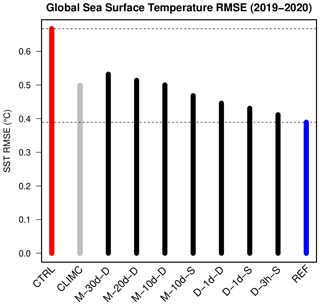
Figure 1Sea surface temperature globally averaged RMSE for the preliminary experiments, over the independent verification period 2019–2020. M-∗ experiments and D-∗ experiments refer to the use of monthly versus daily averaged nudging increments in the ANN training; the second string in the experiment name (30 d, 20 d, …, 3 h) refers to the length of the predictor rolling archive; the last letter refers to the frequency of the update in the online experiments (“D” as daily, “S” as sub-daily, namely every 3 h).
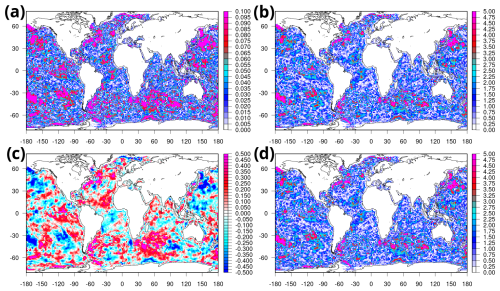
Figure 2Error maps of the reconstructed heat flux correction with test data, i.e. independent data from the training during 2019–2020. (a) Normalized RMSE (dimensionless); (b) RMSE in units of heat flux (W m−2); (c) bias (W m−2); (d) standard deviation of the differences between the original heat flux corrections and those reconstructed with the ANN (W m−2).
Next, we show in Fig. 2 the error maps of the inferred heat flux corrections from the test (i.e. independent) data. The normalized RMSE (Fig. 2a) shows errors smaller than 10 %, and on average equal to 4 % (corresponding to 1.36 W m−2); while errors peak in areas of large mesoscale activity (western boundary currents and the Antarctic Circumpolar Current, ACC), other non-obvious local peaks exist. The systematic error of the ANN reconstructions is very low (Fig. 2c), generally not exceeding 0.7 W m−2, indicating that the RMSE is explained primarily by random errors (Fig. 2d shows the standard deviation of the differences). Note that the grid-point-wise correction implies that the smoothness of the ANN-based correction depends on that of the predictors, i.e. the model fields; we verified the high consistency between the original output and the ANN-inferred one even in individual snapshots (not shown).
Table 1 reports the list of predictors, grouped into categories, together with their impact in terms of variable importance scores (VIS). The VIS for the predictors are calculated using the permutation-based method proposed by Fisher et al. (2019), using the vip R package (Greenwell and Boehmke, 2020), applied either to the entire pre-trained model or pointwise at each model grid point (see Table 1's caption for details). The total VIS refers to the VIS over the full columnar ANN model, while the local VIS is calculated for each grid point by fixing the longitude–latitude pair to the corresponding grid point. The different VIS results respond to different questions – i.e. the total VIS indicates the global impact of each predictor on the final ANN. Diagnosing the local VIS allows investigating regional patterns in variable impact, and Table 1 also reports its spatial average values.
The explainability results for the entire pre-trained model suggest a large impact from static data, wind forcing, and temperature; a significant impact from the heat flux components; and a relatively smaller impact from salinity, freshwater fluxes, and ocean stratification. There may be, however, non-exclusive attributions of errors to predictors, as important correlations between parameters exist. For instance, the VIS for temperature may partly indicate errors in climatological flux (due to the climatological state of the sea surface) or air–sea heat flux (e.g. the upward longwave heat flux); wind forcing may also explain systematic errors in e.g. latent heat flux, and so on for other correlated fields. Due to the strong multivariate nonlinearities in air–sea interactions (e.g. wind stress depends on both near-surface winds and local temperatures via nonlinear bulk formulas), these correlations are not reducible. Hence, we take a practical approach by diagnosing their impact using VIS metrics. In some cases, predictors respond to very similar processes but which are not identical (e.g. wind stress and wind speed differ from the use of sea surface currents in the former).
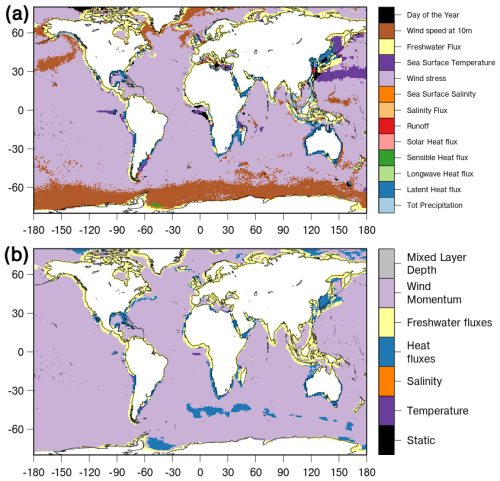
Figure 3Dominant predictors identified using variable importance scores (by individual predictor, a, and by predictor categories, b), from the optimal pre-trained model described in the text. The predictors' list is as in Table 1, but for the sake of clarity, only those predictors with at least one dominant grid point are considered in (a).
Figure 3 shows the most impactful predictors as a function of longitude and latitude (both individual predictors and categories). This indicates that in most of the global ocean, the most important predictor is associated with wind forcing (either wind speed or stress). Interestingly, mesoscale active areas (e.g. western boundary current regions and the Antarctic Circumpolar Current) exhibit turbulent heat fluxes (latent and sensible heat) as the dominant predictor, consistent with the large influence of ocean mesoscale dynamics in the air–sea exchanges therein (see e.g. Frolov et al., 2021). In many coastal regions, the most important predictor is associated with freshwater fluxes. Only a few grid points exhibit another dominant predictor.
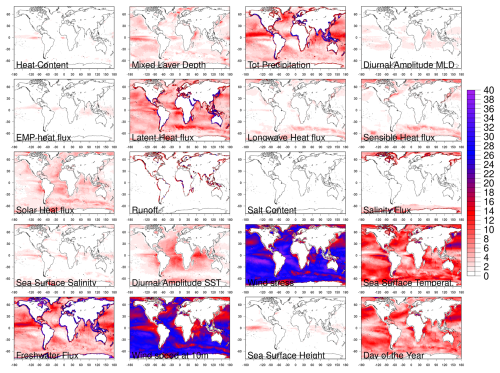
Figure 4The variable importance score (in % values) for each predictor used in the neural network pre-trained model, shown as a function of grid point (i.e. at fixed longitude and latitude values). VIS maps are used to locally attribute different sources of air–sea heat flux errors to the predictors.
Figure 4 shows the individual impact of each predictor (in %), disclosing interesting spatial patterns, closely related to physical and dynamical processes. For instance, the mixed layer depth appears important near the Equator, likely related to ENSO (El Niño–Southern Oscillation) variability; precipitation's impact is relevant in correspondence to the ITCZ (Intertropical Convergence Zone), likely due to its possible misplacement, and around the maritime continent. Eastern boundary upwelling systems are impacted by the solar heat flux and diurnal and seasonal variability (namely, the SST diurnal amplitude and the day of the year, respectively). The salinity flux is relevant over marginal ice zones – in both polar regions – associated with ice-ocean freshwater and heat exchanges; river runoff impacts flux errors in the proximity of shorelines.
2.3 Experimental setup
Several experiments were run using the NEMO ocean model equipped with new functionalities to store in a rolling array the predictors at the desired temporal frequency (see Sect. 2.2 and Fig. 1). We use an in-house Fortran90 library (see the Code Availability section) for online inference from the pre-trained model,as the NEMO model is coded in Fortran. This eases the online inference step. In other words, the prediction step is natively implemented in Fortran90 as an additional NEMO module to avoid the need for external software interfaces. The pre-trained model is loaded at the beginning of the NEMO model integration; then, every 3 h, the inference routine is called, with the predictors average over the latest 24 h as input. The inferred corrective flux is then added to the uncorrected (bulk formula–derived) non–solar heat flux component every 3 h.
The experiments with the ANN-based heat flux correction, presented hereafter, are named NNC (neural-network-based correction) and cover four different scenarios: (i) validation in the training phase (self-consistency), i.e. during the period 2002–2018; (ii) validation in the test phase (independent verification), i.e. during the period 2019–2020, after the training period; (iii) validation in earlier periods, where no dense SST data were available (1961–1979), to test the impact of the new method for retrospective simulations and reanalyses, without any memory in the ocean state initialization; (iv) validation in prediction experiments, namely, 7 d forecasts initialized every 10 d in 2021 and 2022, using the data assimilation–enabled CIGAR reanalysis (Storto and Yang, 2024) and forced at the sea surface by ECMWF operational forecasts, which replace the ERA5 reanalyses used in the scenarios (i)–(iii). These setups allow us to provide a full assessment of the methodology for different applications (such as long- or short-term simulations, historical reanalyses, and operational oceanography).
Further to NNC, we show results from REF (standard SST nudging enabled), CTRL (no corrections), and CLIMC (climatological corrections). The latter corrects air–sea heat fluxes with a monthly climatology of corrections derived from the REF experiment, representing a linear benchmark for the methodology used in the NNC experiment.
3.1 Contemporary simulations
The reconstruction of corrective fluxes with the pre-trained model is shown in Fig. 5, which indicates the close correspondence between the SST nudging–derived and neural network–inferred fields, during the full period 2001–2020. Large corrections occur in mesoscale active areas (given the large but not exclusive role of turbulent heat fluxes; see Figs. 3 and 4), the North Atlantic subpolar gyre (given the significant role of freshwater-related predictors; see Fig. 4), in the tropical ocean and Southern Ocean. Signs are in general reversed in the Northern Hemisphere and Southern Hemisphere during the winter and summer seasons (namely, non-solar heat fluxes are underestimated in wintertime and over-estimated in summertime, because of generally cold and warm biases in SST, respectively). The seasonality of the corrections in deep convection areas also suggests the systematic misrepresentation of the convective processes therein, with much too deep mixed layers in the North Atlantic Ocean, and more complex patterns in the Southern Ocean and ACC region.
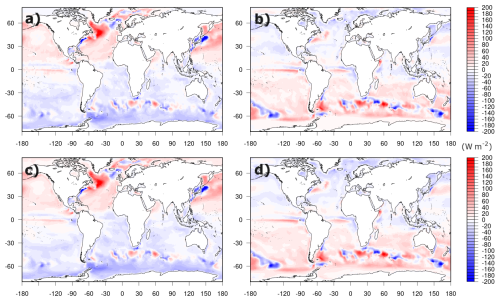
Figure 5Reconstructed heat flux correction fields versus the original ones from the REF (a, b) and NNC (c, d) experiments, for JFM (January, February, and March) (a, c) and JJA (June, July, and August) (b, d) seasonal climatologies, during the 2002–2020 period.
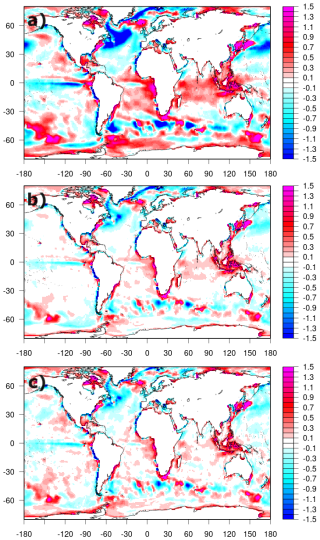
Figure 6SST bias over the independent period 2019–2020 against the SST observations (from UKMO HadISST), for the three experiments CTRL (a), REF (b), and NNC (c).
The application of the correction leads to satisfying bias correction during the independent verification period 2019–2020, as shown in Fig. 6. Large negative biases in the Gulf Stream, Kuroshio Extension, central tropical Pacific, and parts of the Southern Ocean, present in CTRL are equally mitigated in REF and NNC. Likewise, warm biases in the eastern regions of the tropical basins, in the Indian Ocean, and locally elsewhere are also mitigated. Over the mid-latitudes, SST biases approach zero, while elsewhere, the remaining biases that the SST data ingestion was not able to mitigate in the REF experiment are reproduced also in the NNC experiment. The global mean absolute error (MAE) over 2019–2020 decreases from 0.37 °C in CTRL to 0.20 and 0.19 °C in NNC and REF, respectively, while CLIMC exhibits a MAE of 0.23 °C. Differences between NNC and REF experiments are very small and limited only to polar areas (north of 60° N and south of 60° S), where the NNC corrections are small by construction.

Figure 7Mixed layer depth differences with respect to the CTRL experiment during March 2020 (a, c) and September 2020 (b, d), for experiments REF (a, b) and NNC (c, d).
The effects of the correction are also well reproduced in the ocean stratification, shown in Fig. 7 in terms of mixed layer depth differences in March and September 2020 compared to the CTRL experiment. Either the SST assimilation or the neural-network-based heat flux corrections induce an identical shift in the deep convection areas. In the Southern Ocean, during September 2020, a westward shift is visible in the Pacific sector; other local adjustments are visible in both the Atlantic and Indian sectors of the ACC region. Adjustments are also visible in the Atlantic subpolar gyre, where enhanced convection occurs in the Iceland basin and Irminger Sea, equally present in both REF and NNC experiments, along with attenuated mixing south of the Labrador Sea.
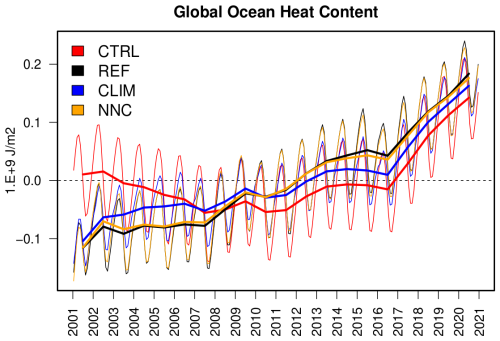
Figure 8Global ocean heat content anomaly vertically integrated over the period 2001–2020 for the four experiments presented in the text, as monthly (thin lines) and yearly (thick lines) means.
The global ocean heat content (OHC) anomaly interannual variations are visible in Fig. 8 and show that NNC and REF lead to the same linear trends and seasonal and interannual variations. Neglecting air–sea heat flux corrections in CTRL produces underestimated global ocean warming (0.15 W m−2), which is identically corrected in NNC and REF (0.41 and 0.43 W m−2, respectively). Using climatological corrections only partly mitigates the warming under-estimation (0.33 W m−2), resulting in an intermediate solution. The correlation of OHC anomalies with respect to independent datasets such as the CIGAR reanalysis is also equally improved (from 0.48 in CTRL to 0.92 in NNC and REF). This suggests that the subsurface signature of the correction method is identical to the original nudging experiment.
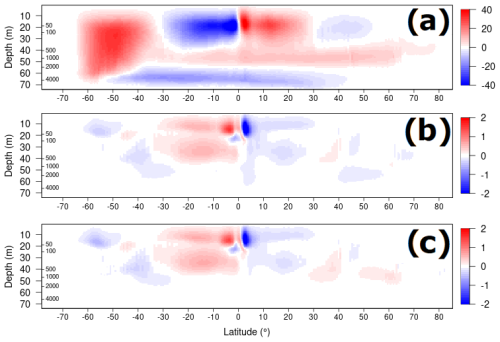
Figure 9Reconstructed global overturning circulation (in Sverdrups, with 1 Sv = 1 × 10+6 m3 s−1) for CTRL (a), and as a difference between CTRL and REF (b), or NNC (c) experiments.
Similarly, the global overturning circulation (Fig. 9) also shows the same behaviour for the REF and NNC experiments, indicating that the dynamical signature of our approach provides the same results as in the assimilation experiment, REF. The assimilation of the SST observations in REF reduces the Northern Hemisphere–Southern Hemisphere contrast of the overturning circulation (Fig. 9b), which is equally found in NNC.
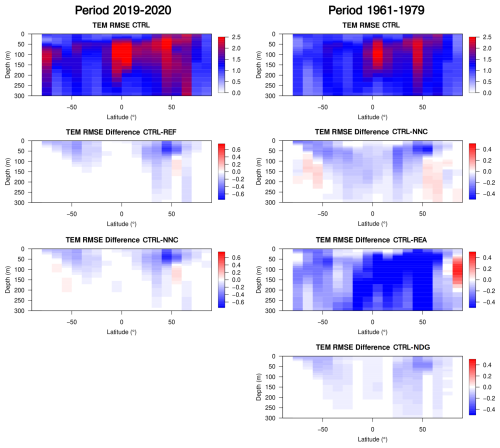
Figure 10Temperature RMSE as a function of latitude and depth for the CTRL experiments (top panels) and for the period 2019–2020 (left) and 1961–1979 (right), and the differences between CTRL and REF or NNC (left) and NNC or REA or NDG (right) for their respective periods. REA is the CIGAR reanalysis, while NDG only ingests mapped in situ SST data from the COBE dataset (Ishii et al., 2005).
Finally, the impact is evaluated against fully independent data, namely, in situ profiles extracted from the UKMO EN4 dataset (Good et al., 2013), during the period 2019–2020. This is shown in Fig. 10 (left panels), where the RMSE of CTRL is shown, together with the differences in RMSE between REF or NNC minus CTRL. Negative (positive) values indicate an improvement (deterioration) borne by the correction method. The figure indicates the comparable impact of the SST nudging and neural network correction on reducing the errors in the subtropical and mid-latitude regions, with the subsurface tropics less impacted by the corrections.
3.2 Retrospective simulations
Retrospective simulations were conducted to evaluate the potential of the method for long-term historical simulations, e.g. for OMIP- and CMIP-like exercises, and in multi-decadal reanalyses where the paucity of observation data in early periods limits the impact of conventional data assimilation and cannot take advantage of spaceborne satellite measurements of SST. To this end, the same set of experiments presented earlier is performed for the period 1961–1979, using the same initial conditions from 1961 taken from the previous simulations.
We show the impact of NNC in terms of RMSE decrease versus the CTRL experiment in Fig. 10, compared also, as an independent reference, to the CIGAR reanalysis (Storto and Yang, 2024) that assimilates all in situ surface and subsurface observations and includes a deep-ocean large-scale bias-correction scheme. Improvements are present everywhere in NNC, except in the high-latitude 100–300 m depth layer; however, the improvements are smaller than those seen in CIGAR, especially in the Northern Hemisphere. The total average improvement (RMSE decrease) in the top 300 m of depth, compared to CTRL, is 22 % for CIGAR and 7 % for NNC, meaning that about one-third of the improvement caused by assimilating the full oceanic observing network and applying conventional bias correction is achieved with the neural-network-based correction. The improvement is remarkable at all latitudes, also in the subsurface tropical region where the correction over the more recent years 2019–2020 failed to provide significant improvement (middle-left panel in Fig. 10). Finally, Fig. 10 also shows a 1961–1979 experiment with nudging to COBE SST (Ishii et al., 2005; experiment NDG); the results show a positive impact for the nudging scheme, although it is generally smaller than the use of ANN to correct sea surface biases.
3.3 Forecast experiments
Forecast experiments are set up with the same model configuration but different initialization and forcing as detailed in Sect. 2.3. The correction is then applied online within the forecasts, as a proof-of-concept for operational purposes. Unlike the nudging scheme, which depends on observational data and cannot be used in forecasts, the ANN-based correction depends only on the oceanic and atmospheric states; thus, it can be adopted in operational forecasting systems.
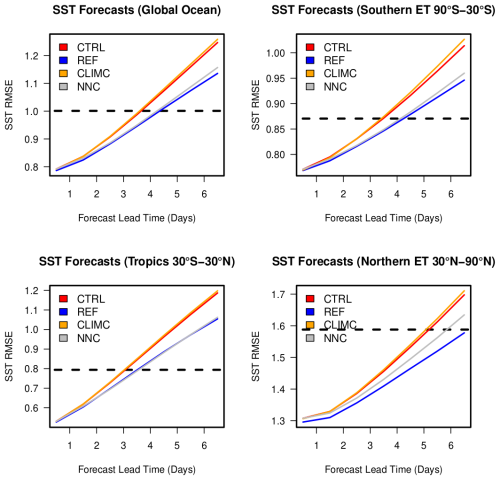
Figure 11Forecast skill score metrics (RMSE), for sea surface temperature at different latitudinal bands, as a function of forecast lead time, for the experiments presented in the text. The dashed line corresponds to the RMSE of climatology, i.e. for values of RMSE greater than the climatology, the forecasts are not useful. Note that the REF experiment is shown as a benchmark, but its setup cannot be used in operational experiments, as it relies on future observations.
Sea surface temperature errors (verified against mapped satellite data from DOISST v2.1, Huang et al., 2021) as a function of forecast lead time (Fig. 11) indicate that NNC provides improvements comparable to nudging – shown as a benchmark – except in the Northern Hemisphere extratropics, likely because of intense mesoscale variability. The climatological corrections (CLIMC) fail to improve the CTRL experiment, as they cannot adapt to the variations in atmospheric forcing in the forecast experiments. Compared to CTRL, and considering the errors given by the climatology (dashed lines in the panels of Fig. 11), the NNC scheme extends the horizon of useful forecasts by about 1 d in all regions. The impact of the method increases with the forecast lead time, suggesting that the approach might be fruitfully applied in long-range forecasting systems (sub-seasonal and beyond), although it should be demonstrated that coupled feedbacks in the case of Earth system models do not compromise the algorithm.
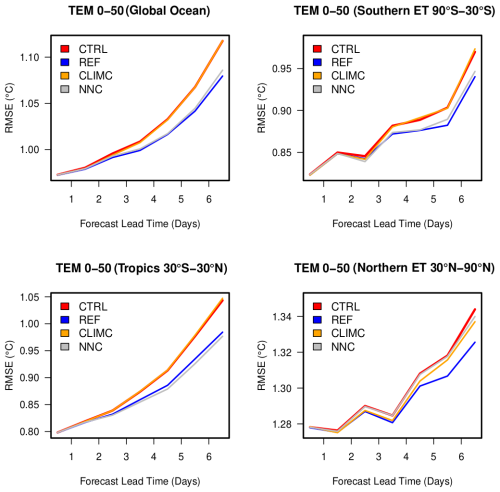
Figure 12As Fig. 11 but for the verification against in situ profiles in the top 50 m of depth.
Similar results are found in the verification against in situ profiles for the upper ocean (sea surface to 50 m of depth), shown in Fig. 12. The top 50 m exhibit significant improvement in the southern extratropics and the tropics, with the improvement borne by NNC increasing with forecast lead time. In the northern extratropics, the ANN correction leads to negligible improvements.
In this work, we propose an algorithm to correct air–sea heat fluxes by letting a neural network pre-trained model learn the relationships between oceanic and atmospheric state predictors and heat flux corrective terms, estimated from a previous experiment that adopted SST nudging to estimate and apply such terms. The predictors include several oceanic and atmospheric variables representative of heat, freshwater, momentum fluxes, ocean temperature and salinity, and stratification. A feed-forward column neural network architecture is adopted, and the NEMO ocean general circulation model is augmented with online inference capability to collect predictors and infer corrections to the air–sea heat fluxes, based on the pre-trained model. Variable importance scores indicate the large impact that wind forcing has on errors in most parts of the global ocean, with other variables dominating locally, e.g. turbulent fluxes in mesoscale active areas and freshwater fluxes near the coasts.
The online use of the correction in the experiments indicates that the approach successfully reproduces the surface, subsurface, and dynamical signature of the SST correction, even beyond the training data period. The corrections are by construction representative of all SST errors that are corrected in the nudging experiments, i.e. not only the heat flux inaccuracies but also other errors, related, for instance, to vertical mixing and solar radiation penetration.
Next, the approach is demonstrated in early periods (1960s and 1970s), where surface temperature data are sparse, to mimic a long-term simulation or reanalysis application. In this context, the methodology provides a significant improvement in subsurface temperature errors, roughly equal to one-third of the improvement in a corresponding reanalysis system, where all available observations are directly assimilated.
We also demonstrate the application of the method in short-range prediction experiments, where observations cannot be used to correct the forecast step; the methodology is proven to significantly reduce surface and subsurface temperature errors, at a negligible extra computational cost and without the use of any observational information, increasing the SST predictability by about 1 d at all latitudes. Subsurface errors are also mitigated everywhere except in the northern extratropics.
We have also demonstrated the significant impact of online inference, which enables high-frequency (3-hourly) updates to the correcting fields. For this reason, testing different model architectures, e.g. those relying on convolutional layers, which require MPI (message passing interface) communication across NEMO domains inside the convolutional filters, was technically complex and demanding. It is not obvious whether convolutional layers are beneficial compared to grid-point-wise corrections (see e.g. different conclusions in Chen et al., 2022; Chapman and Berner, 2024), as the potential advantage of retaining horizontal patterns is balanced by the increased computational needs associated with coarsening the spatial resolution. In the future, more sophisticated inference libraries and tools for online prediction are expected to be available, paving the way for testing different neural network architectures.
While ANNs cannot provide improvements compared to the data assimilative experiments that they are learning from, their use is appealing for several applications that cannot rely on observational input, such as simulations and projections, and multi-decadal reanalyses spanning early periods with scarce observations, as demonstrated in this article. However, applying this method within a coupled ocean–atmosphere model may benefit climate drift correction (e.g. Gupta et al., 2013), but it introduces additional complexities due to nonlinear coupled feedback. In a coupled model, the atmosphere could respond to modified fluxes in a nonlinear and potentially unpredictable manner. Heat flux corrections that work well in an uncoupled system may introduce unintended biases when the atmosphere reacts dynamically, potentially leading to unrealistic SST adjustments. Atmospheric variability (e.g. cloud cover, wind stress, and humidity) will alter in response to changes in SST, which could impact the efficacy of the ANN-based correction. Corrections applied at short timescales may also have long-term impacts on coupled modes of variability (e.g. ENSO or MJO (Madden–Julian oscillation)).
To make the ANN approach more suitable for coupled applications, it could be retrained using data from coupled model reanalyses (e.g. CMIP simulations or CERA reanalysis datasets; Laloyaux et al., 2016), or observations (e.g. Zhou et al., 2024). This would allow the ANN to learn heat flux corrections in a system that accounts for atmospheric responses, analogous to flux correction or flux adjustment techniques (e.g. Sausen et al., 1988). The ANN-based correction could be implemented to maintain the overall coupled energy balance while addressing systematic errors.
Additionally, the algorithm could include corrections also to freshwater and momentum fluxes, subject to long and reliable datasets of e.g. sea surface salinity and currents, to first estimate their corrections, whose availability is limited now.
The method represents the first attempt to leverage data assimilation correction increments, in this case from SST nudging, to learn systematic errors in ocean models. It is also expected that higher-resolution implementations than that presented here may further benefit from the ANN compared to climatological corrections, due to their higher spatial and temporal variability. While providing good results in hindcast mode compared to the control experiment, climatological corrections fail in predictive experiments without proper retuning and re-computation through computationally expensive re-forecast experiments. This in turn suggests the possibility of extending the approach for calibrating forecasts without the need for long re-forecasts.
Further extension of the approach will consider full column increments for three-dimensional corrections, not only associated with heat fluxes but also vertical physics and model parameterizations; while this has been proven successful in atmospheric (e.g. Chen et al., 2022) and sea ice (Gregory et al., 2023) applications, ocean implementations are more challenging due to scarce observing networks in the ocean interior, potentially hampering the use of analysis increments at depth, which is an active area of investigation at the moment.
The NEMO model is available through the official website at https://www.nemo-ocean.eu (last access: 30 July 2025). In-house modifications to the NEMO model code (version 4.0.7) as used in the experiments presented here – including the module for ANN-based corrections, plus other modifications – are available as a Git repository at https://baltig.cnr.it/nemo_ismar-rm/nemo_4.0.7/-/tree/3.0?ref_type=tags (Storto, 2025). There are several additional modifications other than just the ANN correction routine, which can be found in the dnnqcorr module. The ANN correction routine can, however, be isolated by taking only the module dnnqcorr.F90 and adding the call to dnn_qcorr in sbcmod. The library for online inference in Fortran90 used in our NEMO experiments is available as a Git repository at https://baltig.cnr.it/andrea.storto/nnt4nemo/-/tree/main/F90_Inference (last access: 30 July 2025). It includes the ANNIF module for reading pre-trained ANN in the NetCDF format, in addition to inference routines and their tangent linear and adjoint versions. The frozen versions of both source codes, together with the scripts and the data to analyse and plot the results presented in the figures, are available as a dataset at https://doi.org/10.5281/zenodo.13380698 (Storto, 2024).
Atmospheric fields from ECMWF to force the ocean have been taken from the Climate Data Store (CDS, https://doi.org/10.24381/cds.adbb2d47, Hersbach et al., 2023) archive (ERA5) and the operational archive (operational forecasts, see https://www.ecmwf.int, last access: 30 July 2025). SST data are available from the U.K. Met Office Hadley Centre (https://www.metoffice.gov.uk/hadobs/hadisst, Rayner et al., 2003). For verification purposes, we used SST analyses from the NOAA DOISSTv2 dataset (https://psl.noaa.gov/data/gridded/data.noaa.oisst.v2.highres.html, Huang et al., 2021) and in situ profiles from the UK Met Office EN4 dataset (https://www.metoffice.gov.uk/hadobs/en4/download-en4-2-2.html, Good et al., 2013).
AS and SF designed the methodology; AS coded the methodology and ran the experiments; LS and CY provided guidance on the model developments and assessment results. AS drafted the initial version of the manuscript; all the co-authors discussed the results and revised the paper.
The contact author has declared that none of the authors has any competing interests.
Publisher's note: Copernicus Publications remains neutral with regard to jurisdictional claims made in the text, published maps, institutional affiliations, or any other geographical representation in this paper. While Copernicus Publications makes every effort to include appropriate place names, the final responsibility lies with the authors.
We thank Julien Le Sommer (CNRS) for very valuable discussions on strategies to adopt pre-trained neural network models in Fortran90-based numerical models.
This research is supported by programme CN00000013, the “National Centre for HPC, Big Data and Quantum Computing” Directorial Decree (grant no. 1031 of 17 June 2022), from the resources of the PNRR MUR – M4C2 – Investment 1.4 – “National Centers” Directorial Decree (grant no. 3138 of 16 December 2021). NOAA PSL provided financial support for Andrea Storto's visit to PSL in summer 2023.
This paper was edited by Vassilios Vervatis and reviewed by Charles Pelletier and one anonymous referee.
Agarwal, N., Small, R. J., Bryan, F. O., Grooms, I., and Pegion, P. J.: Impact of stochastic ocean density corrections on air-sea flux variability, Geophys. Res. Lett., 50, e2023GL104248, https://doi.org/10.1029/2023GL104248, 2023.
Balmaseda, M. A., Dee, D., Vidard, A., and Anderson, D. L. T.: A multivariate treatment of bias for sequential data assimilation: Application to the tropical oceans, Q. J. Roy. Meteor. Soc., 133, 167–179, https://doi.org/10.1002/qj.12, 2007.
Barnier, B., Madec, G., Penduff, T., Molines, J.-M., Treguier, A.-M., Le Sommer, J., Beckmann, A., Biastoch, A., Böning, C., Dengg, J., Derval, C., Durand, E., Gulev, S., Remy, E., Talandier, C., Theetten, S., Maltrud, M., McClean, J., and De Cuevas, B.: Impact of partial steps and momentum advection schemes in a global ocean circulation model at eddy-permitting resolution, Ocean Dynam., 56, 543–567, https://doi.org/10.1007/s10236-006-0082-1, 2006.
Bonavita, M. and Laloyaux, P.: Machine learning for model error inference and correction, J. Adv. Model. Earth Sy., 12, e2020MS002232, https://doi.org/10.1029/2020MS002232, 2020.
Brodeau, L., Barnier, B., Treguier, A.-M., Penduff, T., and Gulev, S.: An ERA40-based atmospheric forcing for global ocean circulation models, Ocean Model., 31, 88–104, https://doi.org/10.1016/j.ocemod.2009.10.005, 2010.
Brodeau, L., Barnier, B., Gulev, S., and Woods, C.: Climatologically significant effects of some approximations in the bulk parameterizations of turbulent air-sea fluxes, J. Phys. Oceanogr., 47, 5–28, https://doi.org/10.1175/JPO-D-16-0169.1, 2016.
Carton, J. A., Chepurin, G. A., Chen, L., and Grodsky, S. A.: Improved global net surface heat flux, J. Geophys. Res.-Oceans, 123, 3144–3163, https://doi.org/10.1002/2017JC013137, 2018.
Chapman, W. E. and Berner, J.: A State-Dependent Model-Error Representation for Online Climate Model Bias Correction, ESS Open Archive, 23 November 2024, https://doi.org/10.22541/essoar.172526800.05354621/v2, 2024.
Chen, T.-C., Penny, S. G., Whitaker, J. S., Frolov, S., Pincus, R., and Tulich, S.: Correcting systematic and state-dependent errors in the NOAA FV3-GFS using neural networks, J. Adv. Model. Earth Sy., 14, e2022MS003309, https://doi.org/10.1029/2022MS003309, 2022.
Cronin, M. F., Gentemann, C. L., Edson, J., Ueki, I., Bourassa, M., Brown, S., Clayson, C. A., Fairall, C. W., Farrar, J. T., Gille, S. T., Gulev, S., Josey, S. A., Kato, S., Katsumata, M., Kent, E., Krug, M., Minnett, P. J., Parfitt, R., Pinker, R. T., Stackhouse Jr., P. W., Swart, S., Tomita, H., Vandemark, D., Weller, R. A., Yoneyama, K., Yu, L., and Zhang, D.: Air-Sea Fluxes With a Focus on Heat and Momentum, Front. Mar. Sci., 6, 430, https://doi.org/10.3389/fmars.2019.00430, 2019.
Deppenmeier, A. L., Haarsma, R. J., LeSager, P., and Hazeleger, W.: The effect of vertical ocean mixing on the tropical Atlantic in a coupled global climate model, Clim. Dynam., 54, 5089–5109, https://doi.org/10.1007/s00382-020-05270-x, 2020.
Farchi, A., Laloyaux, P., Bonavita, M., and Bocquet, M.: Using machine learning to correct model error in data assimilation and forecast applications, Q. J. Roy. Meteor. Soc., 147, 3067–3084, https://doi.org/10.1002/qj.4116, 2021.
Fisher, A., Rudin, C., and Dominici, F.: All Models are Wrong, but Many are Useful: Learning a Variable's Importance by Studying an Entire Class of Prediction Models Simultaneously, J. Mach. Learn. Res., 20, 1–81, 2019.
Forget, G., Campin, J.-M., Heimbach, P., Hill, C. N., Ponte, R. M., and Wunsch, C.: ECCO version 4: an integrated framework for non-linear inverse modeling and global ocean state estimation, Geosci. Model Dev., 8, 3071–3104, https://doi.org/10.5194/gmd-8-3071-2015, 2015.
Frolov, S., Reynolds, C. A., Alexander, M., Flatau, M., Barton, N. P., Hogan, P., and Rowley, C.: Coupled Ocean–Atmosphere Covariances in Global Ensemble Simulations: Impact of an Eddy-Resolving Ocean, Mon. Weather Rev., 149, 1193–1209, https://doi.org/10.1175/MWR-D-20-0352.1, 2021.
Gaspar, P., Grégoris, Y., and Lefevre, J.-M.: A simple eddy kinetic energy model for simulations of the oceanic vertical mixing: Tests at station Papa and long-term upper ocean study site, J. Geophys. Res., 95, 16179–16193, https://doi.org/10.1029/JC095iC09p16179, 1990.
Good, S. A., Martin, M. J., and Rayner N. A.: EN4: Quality controlled ocean temperature and salinity profiles and monthly objective analyses with uncertainty estimates, J. Geophys. Res.-Oceans, 118, 6704–6716, https://doi.org/10.1002/2013JC009067, 2013 (data available at: https://www.metoffice.gov.uk/hadobs/en4/download-en4-2-2.html, last access: 30 July 2025).
Greenwell, B. M., and Boehmke, B. C.: Variable Importance Plots – An Introduction to the vip Package, R J., 12, 343–366, https://doi.org/10.32614/RJ-2020-013, 2020.
Gregory, W., Bushuk, M., Adcroft, A., Zhang, Y., and Zanna, L.: Deep learning of systematic sea ice model errors from data assimilation increments, J. Adv. Model. Earth Sy., 15, e2023MS003757, https://doi.org/10.1029/2023MS003757, 2023.
Griffies, S. M., Danabasoglu, G., Durack, P. J., Adcroft, A. J., Balaji, V., Böning, C. W., Chassignet, E. P., Curchitser, E., Deshayes, J., Drange, H., Fox-Kemper, B., Gleckler, P. J., Gregory, J. M., Haak, H., Hallberg, R. W., Heimbach, P., Hewitt, H. T., Holland, D. M., Ilyina, T., Jungclaus, J. H., Komuro, Y., Krasting, J. P., Large, W. G., Marsland, S. J., Masina, S., McDougall, T. J., Nurser, A. J. G., Orr, J. C., Pirani, A., Qiao, F., Stouffer, R. J., Taylor, K. E., Treguier, A. M., Tsujino, H., Uotila, P., Valdivieso, M., Wang, Q., Winton, M., and Yeager, S. G.: OMIP contribution to CMIP6: experimental and diagnostic protocol for the physical component of the Ocean Model Intercomparison Project, Geosci. Model Dev., 9, 3231–3296, https://doi.org/10.5194/gmd-9-3231-2016, 2016.
Gupta, A. S., Jourdain, N. C., Brown, J. N., and Monselesan, D.: Climate Drift in the CMIP5 Models, J. Climate, 26, 8597–8615, https://doi.org/10.1175/JCLI-D-12-00521.1, 2013.
Hakuba, M. Z., Fourest, S., Boyer, T., Meyssignac, B., Carton, J. A., Forget, G., Cheng, L., Giglio, D., Johnson, G. C., Kato, S., Killick, R. E., Kolodziejczyk, N., Kuusela, M., Landerer, F., Llovel, W., Locarnini, R., Loeb, N., Lyman, J. M., Mishonov, A., Pilewskie, P., Reagan, J., Storto, A., Sukianto, T., and von Schuckmann, K.: Trends and Variability in Earth's Energy Imbalance and Ocean Heat Uptake Since 2005, Surv. Geophys., 45, 1721–1756, https://doi.org/10.1007/s10712-024-09849-5, 2024.
Hersbach, H., Bell, B., Berrisford, P., Hirahara, S., Horányi, A., Muñoz-Sabater, J., Nicolas, J., Peubey, C., Radu, R., Schepers, D., Simmons, A., Soci, C., Abdalla, S., Abellan, X., Balsamo, G., Bechtold, P., Biavati, G., Bidlot, J., Bonavita, M., De Chiara, G., Dahlgren, P., Dee, D., Diamantakis, M., Dragani, R., Flemming, J., Forbes, R., Fuentes, M., Geer, A., Haimberger, L., Healy, S., Hogan, R., Hólm, E., Janisková, M., Keeley, S., Laloyaux, P., Lopez, P., Lupu, C., Radnoti, G., de Rosnay, P., Rozum, I., Vamborg, F., Villaume, S., and Thépaut, J.-N.: The ERA5 global reanalysis, Q. J. Roy. Meteor. Soc., 146, 1999–2049, https://doi.org/10.1002/qj.3803, 2020.
Hersbach, H., Bell, B., Berrisford, P., Biavati, G., Horányi, A., Muñoz Sabater, J., Nicolas, J., Peubey, C., Radu, R., Rozum, I., Schepers, D., Simmons, A., Soci, C., Dee, D., and Thépaut, J.-N.: ERA5 hourly data on single levels from 1940 to present, Copernicus Climate Change Service (C3S) Climate Data Store (CDS) [data set], https://doi.org/10.24381/cds.adbb2d47, 2023.
Hornik, K., Stinchcombe, M., and White, H.: Multilayer feedforward networks are universal approximators, Neural Networks, 2, 359–366, https://doi.org/10.1016/0893-6080(89)90020-8, 1989.
Huang, B., Liu, C., Banzon, V., Freeman, E., Graham, G., Hankins, B., Smith, T., and Zhang, H.-M.: Improvements of the Daily Optimum Interpolation Sea Surface Temperature (DOISST) Version 2.1, J. Climate, 34, 2923–2939, https://doi.org/10.1175/JCLI-D-20-0166.1, 2021 (data available at: https://psl.noaa.gov/data/gridded/data.noaa.oisst.v2.highres.html, last access: 30 July 2025).
Huber, M. B. and Zanna, L.: Drivers of uncertainty in simulated ocean circulation and heat uptake, Geophys. Res. Lett., 44, 1402–1413, https://doi.org/10.1002/2016GL071587, 2017.
Ishii, M., Shouji, A., Sugimoto, S., and Matsumoto, T.: Objective analyses of sea-surface temperature and marine meteorological variables for the 20th century using ICOADS and the Kobe Collection, Int. J. Climatol., 25, 865–879, 2005.
Jia, Y., Richards, K. J., and Annamalai, H.: The impact of vertical resolution in reducing biases in sea surface temperature in a tropical Pacific Ocean model, Ocean Model., 157, 101722, https://doi.org/10.1016/j.ocemod.2020.101722, 2021.
Kato, S., Loeb, N. G., Rose, F. G., Doelling, D. R., Rutan, D. A., Caldwell, T. E., Yu, L., and Weller, R. A.: Surface irradiances consistent with CERES-derived top-of-atmosphere shortwave and longwave irradiances, J. Climate, 26, 2719–2740, 2013.
Laloyaux, P., Balmaseda, M., Dee, D., Mogensen, K., and Janssen, P.: A coupled data assimilation system for climate reanalysis, Q. J. Roy. Meteor. Soc., 142, 65–78, 2016.
Large, W. G. and Yeager, S. G.: The global climatology of an interannually varying air–sea flux data set, Clim. Dynam., 33, 341–364, https://doi.org/10.1007/s00382-008-0441-3, 2009.
Lewis, H. W., Siddorn, J., Castillo Sanchez, J. M., Petch, J., Edwards, J. M., and Smyth, T.: Evaluating the impact of atmospheric forcing and air–sea coupling on near-coastal regional ocean prediction, Ocean Sci., 15, 761–778, https://doi.org/10.5194/os-15-761-2019, 2019.
Lin, X., Massonnet, F., Fichefet, T., and Vancoppenolle, M.: Impact of atmospheric forcing uncertainties on Arctic and Antarctic sea ice simulations in CMIP6 OMIP models, The Cryosphere, 17, 1935–1965, https://doi.org/10.5194/tc-17-1935-2023, 2023.
Madec, G. and The NEMO System Team: NEMO Ocean Engine, Note Du Pole De Modélisation, Institut Pierre-Simon Laplace, Paris, France, https://doi.org/10.5281/zenodo.3248739, 2017.
Marzocchi, A., Nurser, A. J. G., Clément, L., and McDonagh, E. L.: Surface atmospheric forcing as the driver of long-term pathways and timescales of ocean ventilation, Ocean Sci., 17, 935–952, https://doi.org/10.5194/os-17-935-2021, 2021.
Mitchell, L. and Carrassi, A.: Accounting for model error due to unresolved scales within ensemble Kalman filtering, Q. J. Roy. Meteor. Soc., 141, 1417–1428, https://doi.org/10.1002/qj.2451, 2015.
Ohishi, S., Miyoshi, T., and Kachi, M.: Impact of atmospheric forcing on SST biases in the LETKF-based ocean research analysis (LORA), Ocean Model., 189, 102357, https://doi.org/10.1016/j.ocemod.2024.102357, 2024.
Rayner, N. A., Parker, D. E., Horton, E. B., Folland, C. K., Alexander, L. V., Rowell, D. P., Kent, E. C., and Kaplan, A.: Global analyses of sea surface temperature, sea ice, and night marine air temperature since the late nineteenth century, J. Geophys. Res., 108, 4407, https://doi.org/10.1029/2002JD002670, 2003 (data available at: https://www.metoffice.gov.uk/hadobs/hadisst, last access: 30 July 2025).
Richards, K. J., Xie, S., and Miyama, T.: Vertical Mixing in the Ocean and Its Impact on the Coupled Ocean–Atmosphere System in the Eastern Tropical Pacific, J. Climate, 22, 3703–3719, https://doi.org/10.1175/2009JCLI2702.1, 2009.
Roberts, M. J., Hewitt, H. T., Hyder, P., Ferreira, D., Josey, S. A., Mizielinski, M., and Shelly, A.: Impact of ocean resolution on coupled air-sea fluxes and large-scale climate, Geophys. Res. Lett., 43, 10430–10438, https://doi.org/10.1002/2016GL070559, 2016.
Sausen, R., Barthel, K., and Hasselmann, K.: Coupled ocean-atmosphere models with flux correction, Clim. Dynam., 2, 145–163, https://doi.org/10.1007/BF01053472, 1988.
Small, R. J., Bryan, F. O., Bishop, S. P., and Tomas, R. A.: Air–Sea Turbulent Heat Fluxes in Climate Models and Observational Analyses: What Drives Their Variability?, J. Climate, 32, 2397–2421, https://doi.org/10.1175/JCLI-D-18-0576.1, 2019.
Storto, A.: Assets (code, scripts and datasets) for the manuscript “Correction of the Air-Sea Heat Fluxes in Ocean General Circulation Models Using Neural Networks” (1.0), Zenodo [Data set and Code], https://doi.org/10.5281/zenodo.13380698, 2024.
Storto, A.: NEMO_4.0.7, GitLab [code], https://baltig.cnr.it/nemo_ismar-rm/nemo_4.0.7/-/tree/3.0?ref_type=tags (last access: 30 July 2025), 2025.
Storto, A. and Oddo, P.: Optimal Assimilation of Daytime SST Retrievals from SEVIRI in a Regional Ocean Prediction System, Remote Sens.-Basel, 11, 2776, https://doi.org/10.3390/rs11232776, 2019.
Storto, A. and Yang, C.: Stochastic schemes for the perturbation of the atmospheric boundary conditions in ocean general circulation models, Front. Mar. Sci., 10, 1155803, https://doi.org/10.3389/fmars.2023.1155803, 2023.
Storto, A. and Yang, C.: Acceleration of the ocean warming from 1961 to 2022 unveiled by large-ensemble reanalyses, Nat. Commun., 15, 545, https://doi.org/10.1038/s41467-024-44749-7, 2024.
Storto, A., Yang, C., and Masina, S.: Sensitivity of global ocean heat content from reanalyses to the atmospheric reanalysis forcing: A comparative study, Geophys. Res. Lett., 43, 5261–5270, https://doi.org/10.1002/2016GL068605, 2016a.
Storto, A., Masina, S., and Navarra, A.: Evaluation of the CMCC eddy-permitting global ocean physical reanalysis system (C-GLORS, 1982–2012) and its assimilation components, Q. J. Roy. Meteor. Soc., 142, 738–758, https://doi.org/10.1002/qj.2673, 2016b.
Storto, A., Balmaseda, M. A., de Boisseson, E., Giese, B. S., Masina, S., and Yang, C.: The 20th century global warming signature on the ocean at global and basin scales as depicted from historical reanalyses, Int. J. Climatol., 41, 5977–5997, https://doi.org/10.1002/joc.7163, 2021.
Tsujino, H., Urakawa, S., Nakano, H., Small, R. J., Kim, W. M., Yeager, S. G., Danabasoglu, G., Suzuki, T., Bamber, J. L., Bentsen, M., Böning, C. W., Bozec, A., Chassignet, E. P., Curchitser, E., Boeira Dias, F., Durack, P. J., Griffies, S. M., Harada, Y., Ilicak, M., Josey, S. A., Kobayashi, C., Kobayashi, S., Komuro, Y., Large, W. G., Le Sommer, J., Marsland, S. J., Masina, S., Scheinert, M., Tomita, H., Valdivieso, M., and Yamazaki, D.: JRA-55 based surface dataset for driving ocean-sea-ice models (JRA55-do), Ocean Model., 130, 79–139, https://doi.org/10.1016/j.ocemod.2018.07.002, 2018.
Valdivieso, M., Haines, K., Balmaseda, M., Chang, Y.-S., Drevillon, M., Ferry, N., Fujii, Y., Kohl, A., Storto, A., Toyoda, T., Wang, X., Waters, J., Xue, Y., Yin, Y., Barnier, B., Hernandez, F., Kumar, A., Lee, T., Masina, S., Peterson, A. k.: An assessment of air–sea heat fluxes from ocean and coupled reanalyses, Clim. Dynam., 49, 983–1008, https://doi.org/10.1007/s00382-015-2843-3, 2017.
Vidard, P. A., Le Dimet, F.-X., and Piacentini, A.: Determination of optimal nudging coefficients, Tellus A, 55, 1–15, 2003.
Waters, J., Lea, D. J., Martin, M. J., Mirouze, I., Weaver, A., and While, J.: Implementing a variational data assimilation system in an operational 1/4 degree global ocean model, Q. J. Roy. Meteor. Soc., 141, 333–349, https://doi.org/10.1002/qj.2388, 2015.
Yang, C., Masina, S., and Storto, A.: Historical ocean reanalyses (1900–2010) using different data assimilation strategies, Q. J. Roy. Meteor. Soc., 143, 479–493, https://doi.org/10.1002/qj.2936, 2017.
Yu, L.: Global air–sea fluxes of heat, fresh water, and momentum: energy budget closure and unanswered questions, Annu. Rev. Mar. Sci., 11, 227–248, https://doi.org/10.1146/annurev-marine-010816-060704, 2019.
Zhou, S., Shi, R., Yu, H., Zhang, X., Dai, J., Huang, X., and Xu, F.: A physical-informed neural network for improving air-sea turbulent heat flux parameterization, J. Geophys. Res.-Atmos., 129, e2023JD040603, https://doi.org/10.1029/2023JD040603, 2024.
Zou, X., Navon, I. M., and Ledimet, F. X.: An optimal nudging data assimilation scheme using parameter estimation, Q. J. Roy. Meteor. Soc., 118, 1163–1186, 1992.
Inaccuracies in air–sea heat fluxes severely degrade the accuracy of ocean numerical simulations. Here, we use artificial neural networks to correct air–sea heat fluxes as a function of oceanic and atmospheric state predictors. The correction successfully improves surface and subsurface ocean temperatures beyond the training period and in prediction experiments.
Inaccuracies in air–sea heat fluxes severely degrade the accuracy of ocean numerical...




